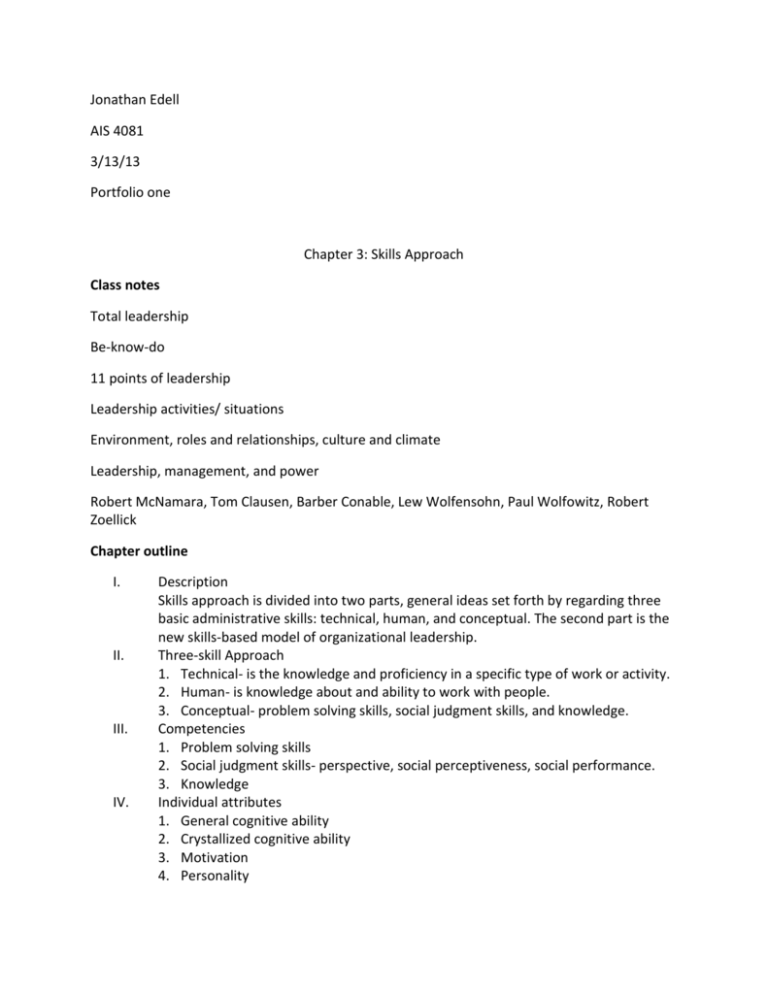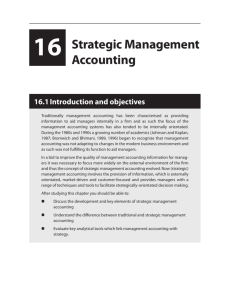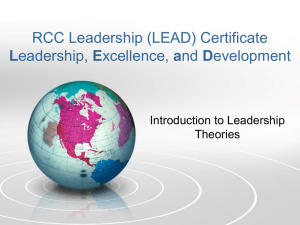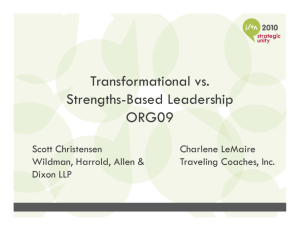leadership theory and practice portfolio 1
advertisement

Jonathan Edell AIS 4081 3/13/13 Portfolio one Chapter 3: Skills Approach Class notes Total leadership Be-know-do 11 points of leadership Leadership activities/ situations Environment, roles and relationships, culture and climate Leadership, management, and power Robert McNamara, Tom Clausen, Barber Conable, Lew Wolfensohn, Paul Wolfowitz, Robert Zoellick Chapter outline I. II. III. IV. Description Skills approach is divided into two parts, general ideas set forth by regarding three basic administrative skills: technical, human, and conceptual. The second part is the new skills-based model of organizational leadership. Three-skill Approach 1. Technical- is the knowledge and proficiency in a specific type of work or activity. 2. Human- is knowledge about and ability to work with people. 3. Conceptual- problem solving skills, social judgment skills, and knowledge. Competencies 1. Problem solving skills 2. Social judgment skills- perspective, social perceptiveness, social performance. 3. Knowledge Individual attributes 1. General cognitive ability 2. Crystallized cognitive ability 3. Motivation 4. Personality V. VI. VII. VIII. Leadership outcomes 1. Effective problem solving 2. Performance Career Experiences Environmental Influences Internal and external Strengths 1. Stresses importance of developing particular leadership skills 2. The skills approach is intuitively appealing 3. Provides an expansive view of leadership that incorporates a wide variety of components, including problem-solving skills, social judgment skills, knowledge, individual attributes, career experiences and environmental influences. 4. Provides a structure that is very consistent with the curricula of most leadership education programs. Case studies 3.1 Strained research team 1. He has a very negative leadership approach where he lets his personal emotions and feelings get the best of him. If he continues down this current path his project will be unsuccessful due to lack of moral. 2. Yes, he is qualified to lead the team it is up to him to put the pieces together to solve the problem and accomplish the goal of the project. 3. His problem-solving skills clearly need work if these were a strong point he would have figured out how to turn the project around already. Also, his social judgment skills are another area to focus on. He needs to do a better job controlling emotions and building moral. Finally, his knowledge is unprecedented but he could be a better leader. 3.2 A shift for Lieutenant Colonel Adams 1. He had the ability to meet the challenges, but he lacked in the appropriate reduction of staff. He struggles with problem solving and knowledge of how to properly lead a large group toward the ultimate goal. 2. When he was confronted by additional tasks he could meet the necessary requirements, but his plan for cutting staff members was ineffective, this really emphasized his weakness in this area. 3. I would tell him to slow down, take a longer look at the big picture and then make decisions. His current strategy ready, shoot, aim is not effective. 3.3 Andy’s Recipe 1. Andy’s success is due in part because of his high quality customer service. He believes if you treat them right, they will treat you right. 2. Kelly needs to work on social judgment skills. Danielle needs to work on her knowledge of numbers. Patrick needs to work on his social judgment skills to help with his poor communication. 3. Andy needs to work on his knowledge of numbers to make the business more profitable. No, I think he wants them to do their best but he does not know how to correct there inefficiencies to make them truly better employees. Leadership instrument Skills inventory Total scores: technical 25, human 21, conceptual 27 Chapter 4: Style Approach Class notes Leadership activity: Reality Check Process of great leadership Figure 3.1 Leadership as a skill: cognitive, perceptual, motor Gathering info, giving info, influencing behavior, handling emotion Four pillars: Leadership, management, command and control Structural, HR, political, symbolic Leadership matrix: socialite, team leadership, impoverished, authoritarian Hierarchy of needs: self-actualization, esteem, belongingness and love, safety, physiological Herzberg’s hygiene and motivational factors Chapter outline I. Description II. III. IV. V. VI. VII. The style approach emphasizes the behavior of the leader. The two general kinds of behaviors: task and relationship. The Ohio State Studies - Initiating structure (task) - Consideration (relationship) The University of Michigan Studies - Employee orientation (relationship) - Production orientation (task) Blake and Mouton’s managerial (leadership) grid - Concern for production (task) - Concern for people (relationship) 1. Authority-compliance (9,1) 2. Country- Club management (1,9) 3. Impoverished Management (1,1) 4. Middle of the road management (5,5) 5. Team Management (9,9) 6. Paternalism/maternalism 7. Opportunism How does the style approach work? Task and relationship Strengths Easy to use and understand Criticisms Failed to find a universal style of leadership Case studies 4.1 A Drill Sergeant at First 1. I would describe mark’s style as assertive and task orientated and then slowly becoming more relationship based once the task is achieved. 2. He went to a more relationship based behavior as opposed to task orientated. 3. Task for sure. He has a clear goal in mind. 4. 5,5 4.2 Eating lunch standing up 1. She is very task orientated and struggles with relationships at work and at home. 2. Most people are either task orientated or relationship orientated. Those that like her style are task orientated. Those who do not like her style are relationship orientated individuals. 3. I think she doesn’t have to change but rather just open up with employees more and increase communication. 4. I think it would take a while for the employees to warm up to the idea, but I do think it would be effective. 4.3 We are family 1. Betsy is very task orientated while Marianne is very relationship orientated. 2. She does need to change her style to make herself more personable but she needs to make sure to not give in to what they want. 3. They need to set the rules and both have to agree with the rules, this will keep the peace. Leadership Instrument Style questionnaire Total scores: Task 40, Relationship 42 Chapter 5: Situational Approach Class notes Style leadership: Task and relationship Situational leadership See graphic Telling, selling, participating, delegating M1, M2, M3, M4: S1, S2, S3, S4 Supervision for leaders Communication and leadership Active listening, culture Carl Rogers Paul Ekman Happiness, sadness, anger, fear, disgust, surprise Chapter outline I. Description One of the more widely recognized approaches to leadership is the situational approach, which was developed by Hershey and Blanchard based on Reddins 3-D management style theory. II. III. IV. V. VI. VII. See figure 5.1 Leadership Styles Leadership style consists of the behavior pattern of a person who attempts to influence others. Directive (task) Supportive (relationship) High directive-low supportive style (directing) High directive-high supportive style High supportive-low directive style Low supportive-low directive style (delegating) Development levels A second major part of the situational leadership model concerns the development level of subordinates. How does the situational approach work? The situational approach is constructed around the idea that employees move forward and backward along the developmental continuum, which represents the relative competence and commitment of subordinates. Strengths - Stood the test of time in the marketplace - Its practicality - Its prescriptive value - It emphasizes leader flexibility - Treat each subordinate differently based on the task at hand and to seek opportunities to help subordinates learn new skills and become more confident in their work Criticisms - Only few research studies have been conducted to justify the assumptions and propositions set forth by the approach - The ambiguous conceptualization in the model of subordinate’s development levels. - How the model matches leader style with subordinate development levels - It fails to account for how certain demographic characteristics (education, experience, age, and gender) - Questionnaires Application Case studies 5.1, 5.2,5.3 Case Studies Case 5.1 1. Rick is s2, Beth is s3, Steve is s1. 2. No, they each have a different leadership style and ideas. I would treat each one as an individual and address them with individual goals and objectives. 3. The hardest would be talking to Beth as to why she had such a lofty goal of 30% and only brought in 2%. The easiest would be motivating Steve that he has what it takes to be an outstanding production manager. Case 5.2 1. S2, coaching 2. Middle 3. He needs to analyze the situation and make the necessary adjustments to improve attendance and keep the content engaging and fun. 4. Incentives for attendance, company recognition, and utilizing time to the max cut down on coffee breaks and shorten the total time of the seminar. Case 5.3 1. Ann has no strong leadership in her radio station and her students are breaking FCC rules and costing the radio station. 2. S2, coaching because she can be friendly and still get her point across. 3. A punishment system for offenses, a reward system for not having offenses, more structure. Leadership instrument Situation 1 A Situation 2 C Situation 3 C Situation 4 C Chapter 6: Contingency theory Class notes Contingency theory leadership Leader-member relationships Degree of task structure Leader’s position power Assumptions Descriptions Figure 1 ADDIE method PAQ A: motivation B: resources and environment C: selection D: training Chapter Outline I. II. III. IV. Description Contingency theory is concerned with styles and situations. It provides the framework for effectively matching the leader and the situation. 1. Leadership styles a. Task motivated b. Relationship motivated 2. Situational variables a. Leader-member relations b. Task structure c. Position power How does contingency theory work? Measuring and scoring the 3 situational variables Strengths 1. Great deal of empirical research 2. Forces us to consider the impact of situations on leaders 3. Predictability 4. No need to be perfect at everything Criticisms 1. Fails to explain why some styles are more effective than others in specific situations. 2. The LPC scale 3. No plan in case of mismatch Case Studies 6.1 No control over the student council 1. She will be a good president of the student council. I just think that her position is pointless without control. 2. She scored a 98 on her LPC, which is high. This high score represents a person who is usually relationship orientated. She needs to focus on achieving the goal and becoming more tasks orientated. 3. She will struggle in this process but in the end she will be successful. 4. She needs to make it so she has some control of the situation and finalize a plan for fix the issue. 6.2 Giving him a hard time 1. Bill scored a 44 on the LPC and that is good, he has high structure, and strong power. He is very task orientated. 2. I think he will be successful but it will be a challenge because of his poor interpersonal relationships with the students. 3. I would add a second teacher to help that is relationship orientated to raise moral of the students. 6.3 What’s the best leader match? 1. I would choose Bill for the job due to the fact that he is a relationship based person and team work requires relationships. Martha would be too much of the same if they choose her for this position. 2. No, they do not need to do this. All they need to do is have the employee take the LPC test and there score will be the determining factor. 3. Yes, I think this is perfectly good option for choosing the correct employee for the job. Leadership Instrument Scoring Interpretation LPC 51, low LPC suggests that I am task motivated Chapter 7: Path-Goal theory Class notes 4 characteristics of goal setting Difficulty, specificity, feedback, participation in goal setting Vision-goals-objectives-tasks-timelines-follow-up Path goal theory Performance excellence Learning through reflections: absorb, do, interact Chapter Outline I. II. III. IV. Description Path-goal theory is about how leaders motivate subordinates to accomplish designated goals. 1. Leader behaviors 2. Directive leadership 3. Supportive leadership 4. Participative leadership 5. Achievement-orientated leadership 6. Subordinate characteristics 7. Task characteristics How does Path-Goal theory work? Path-goal theory is an approach to leadership that is not only theoretically complex, but also pragmatic. Strengths 1. Useful theoretical framework for understanding how various leadership behaviors affect subordinates’ satisfaction and work performance. 2. Attempts to integrate the motivation principles of expectancy theory into a theory of leadership. 3. Provides a model that in certain ways is very practical. Criticisms 1. Is so complex and incorporates so many different aspects of leadership that interpreting the theory can be confusing. 2. Only partial support from the many empirical research studies that have been conducted to test its validity. 3. Fails to explain the relationship between leadership behavior and worker motivation. Case Studies 7.1 Three shifts, three supervisors 1. Art is too hands on, he spends his time correcting everyone verbally and not showing them how to do it the right way. Bob is to people orientated and sometimes he forgets the task and that’s why his turnover is high. 2. Leadership style clearly affects motivation levels. Art has high attendance but low morale. Bob has poor attendance but high morale. Carol has high attendance and high morale but quality of employees when they switch shifts is poor. 3. I would have art be less hands on, I would have bob focus more on the task at hand, and carol I would have her make her employees more independent. 7.2 Direction for some, support for others 1. He allows the necessary space for those who need it as has the ability to identify employees who need his guidance. 2. He allows them to feel comfortable so productivity is high, in fact employee motivation allows his store to be more profitable that both of the chain copy store in the area combined. 3. With the two different jobs he allows the independent ones to have space and the only that require assistance he helps immediately. 4. He could look into an incentive program to increase business and employee morale. 7.3 Marathon runners at different levels 1. He should approach the first group using the supportive leadership behavior, this meaning he provides nurturance. The middle group he should use the directive leadership behavior, meaning he provides guidance and psychological structure. Finally, he should use an achievement orientated leadership behavior, meaning he provides challenges. 2. He needs to set S.M.A.R.T goals specific to each individual. 3. The only obstacle is his lack of creativity in the training routine. 4. Identify each group, make a plan for change, execute plan, evaluate. Leadership instrument Path-Goal leadership questionnaire Directive 27 Supportive 30 Participative 28 Achievement-orientated 28 Chapter 8: Leader-Member Exchange theory Class notes Leader member exchange theory LMX The Empathy Quotient EQ Take EQ test Chapter outline I. II. III. IV. Description The leader member exchange (LMX) theory takes still another approach and conceptualizes leadership as a process that is centered on the interactions between leaders and followers. 1. Early studies Vertical linkages In-group Out-group 2. Later studies Organizational effectiveness 3. Leadership making High quality exchanges with all of the leaders subordinates rather than just a few How does the LMX theory work? 1. Describes leadership 2. Prescribes leadership Strengths 1. Strong descriptive theory 2. Makes the concept of dyadic relationship the centerpiece 3. Importance of communication Criticisms 1. Vertical dyad linkage theory 2. Not fully developed ideas 3. Not fully explained contextual factors Case studies 8.1 His team gets the best assignments 1. She clearly shows a little bit of favoritism towards jack and his team. This is noticed immediately due to the unfavorable responses from the other team leaders toward Carly. 2. The In-group is jack and a little bit of Terri, while on the other side the out-groups are Julie and Sarah. 3. The teams still are able to complete their work on time so it is not completely counterproductive but Carly could do a better job of spreading the love to the other teams and keep morale up in the department. 4. Yes, I think she should start by spreading out assignments to all the teams and have monthly associate director meetings in a group setting and individually to keep them all on the same page. 8.2 Working hard at being fair 1. I think she is a great leader and I really like how she keeps order in the office and try’s very hard to limit favoritism. 2. From what the case said she appears to have a very happy and open staff that works hard for her because she works very hard for them. 3. Yes, my style and Jenny’s style are very similar and I really like the idea the stained glass at the party, I am going to use that this year! 8.3 Taking on additional responsibilities 1. He appears to be a good leader but he should do a better job of distributing responsibilities to other office member. Having a select few employees is a great idea but if you can get them to do a little bit of cross training in all aspects of the business then they will all feel equal. 2. In groups are Shirley and Patti, Ted and Jana, and Glenda and Annie. The out group is the rest of the staff that is considered to be the slow employees. 3. Productive to a certain extent the work is getting completed, but morale is down because he has the same people do the same task each time. He could switch up the teams and incorporate new employees to increase productivity in all aspects of the business environment. Leadership instrument Scoring interpretation LMX 7: 27 moderate Chapter 9: Transformational Leadership Class notes Character and traits in leadership Beliefs values, skills, traits Broadminded, competent, courageous, fair-minded, forward-looking, honest, inspiring, intelligent, straightforward JJ did tie buckle Justice, judgment, dependability, initiative, decisiveness, tact, integrity, enthusiasm, bearing, uselfishness Inspirational motivation, intellectual stimulation, idealized influence, individualized consideration Chapter outline I. 1. 2. 3. 4. 5. 6. 7. 8. 9. Description Transformational leadership is part of the “New Leadership” paradigm, which gives more attention to the charismatic and affective elements of leadership. Transformational Leadership defined a. Transactional b. Transformational Transformational Leadership and Charisma a. Table 9.1 A model of transformational leadership a. Bass b. Leadership continuum Transformational leadership factors a. Idealized influence b. Inspirational motivation c. Intellectual stimulation d. Individualized consideration Transactional leadership factors a. Contingent reward b. Management-by-exception Nonleadership factor a. Laissez-Faire Other transformational perspectives Bennis and Nanus Kouzes and Posner a. Model the way b. Inspire a shared vision II. III. IV. c. Challenge the process d. Enable others to act e. Encourage the heart How does the transformational approach work? The transformational approach to leadership is a broad-based perspective that encompasses many facets and dimensions of the leadership process. Strengths 1. Widely researched 2. Intuitive appeal 3. It’s a process 4. Broader view 5. Strong emphasis on followers’ needs, values, and morals Criticisms 1. Lack conceptual clarity 2. Challenged validity of MLQ 3. Treats leadership as a personality trait 4. Might now actually transform anyone 5. Elitist and antidemocratic 6. Potential to be abused Case Studies 9.1 The vision failed 1. I would have them think long and hard about this vision and if it aligns with the current company vision and culture. Is he using a top down or bottom up approach? 2. He had a rather lengthy 2 page vision that must have sounded great on paper but could not make it work in the implementation process. 3. He was a poor change agent at HTE, he seemed to ruin moral and employee commitment to the company. His top down approach lack of effective two way communication was his down fall. 4. Listen to the employees and consult with managers prior to implementing his personal plan. 9.2 An exploration in Leadership 1. He had to change to help steer the group in the right direction, this is an excellent example of transformational leadership. 2. Transformational four I’s, this description seems to be the most fitting for his particular leadership style. 3. He expects them to be ready to go on time, utilize the specific strengths of each individual, and help them learn more about his passion for archaeology. 9.3 Her vision of a model research center 1. She shows that she is not only invested financially but also emotionally in the company. She goes above and beyond to be the best leader she can be. This is through many onsite work related benefit programs such as full time benefits for part time employees and flexible schedules. 2. It is causing her to have to be out of the office more and she does not like this transition. She wants to spend more time in the office conducting daily task with employees but due to her schedule she can no longer have her weekly meeting with supervisors. 3. Hire more employees, and promote from within to relieve some of the load. So she can be around more often to keep business running smoothly. Leadership Instrument MLQ Transformational 4, 4,4,3,4 Transactional 2, 2 Passive/avoidant 3, 1 Chapter 10: Servant Leadership Chapter outline I. Description Servant leadership is a paradox- an approach to leadership that runs counter to common sense. 1. Servant leadership defined 2. Historical basis of servant leadership 3. Ten characteristics of a servant leader a. Listening b. Empathy c. Healing d. Awareness e. Persuasion f. Conceptualization g. Foresight h. Stewardship i. Commitment to the growth of people j. Building community 4. Building a theory about servant leadership Table 10.1 II. Model of servant leadership a. Antecedent conditions 1. Context and culture 2. Leader attributes 3. Follower receptivity b. Servant leader behaviors 1. Conceptualizing 2. Emotional healing 3. Putting followers first 4. Helping followers grow and succeed 5. Behaving ethically 6. Empowering 7. Creating value for the community c. Leadership outcomes 1. Follower performance and growth 2. Organizational performance 3. Societal impact III. How does servant leadership work? Servant leadership works best when leaders are altruistic and have a strong motivation and deep-seated interest in helping others. IV. Strengths V. Criticisms




